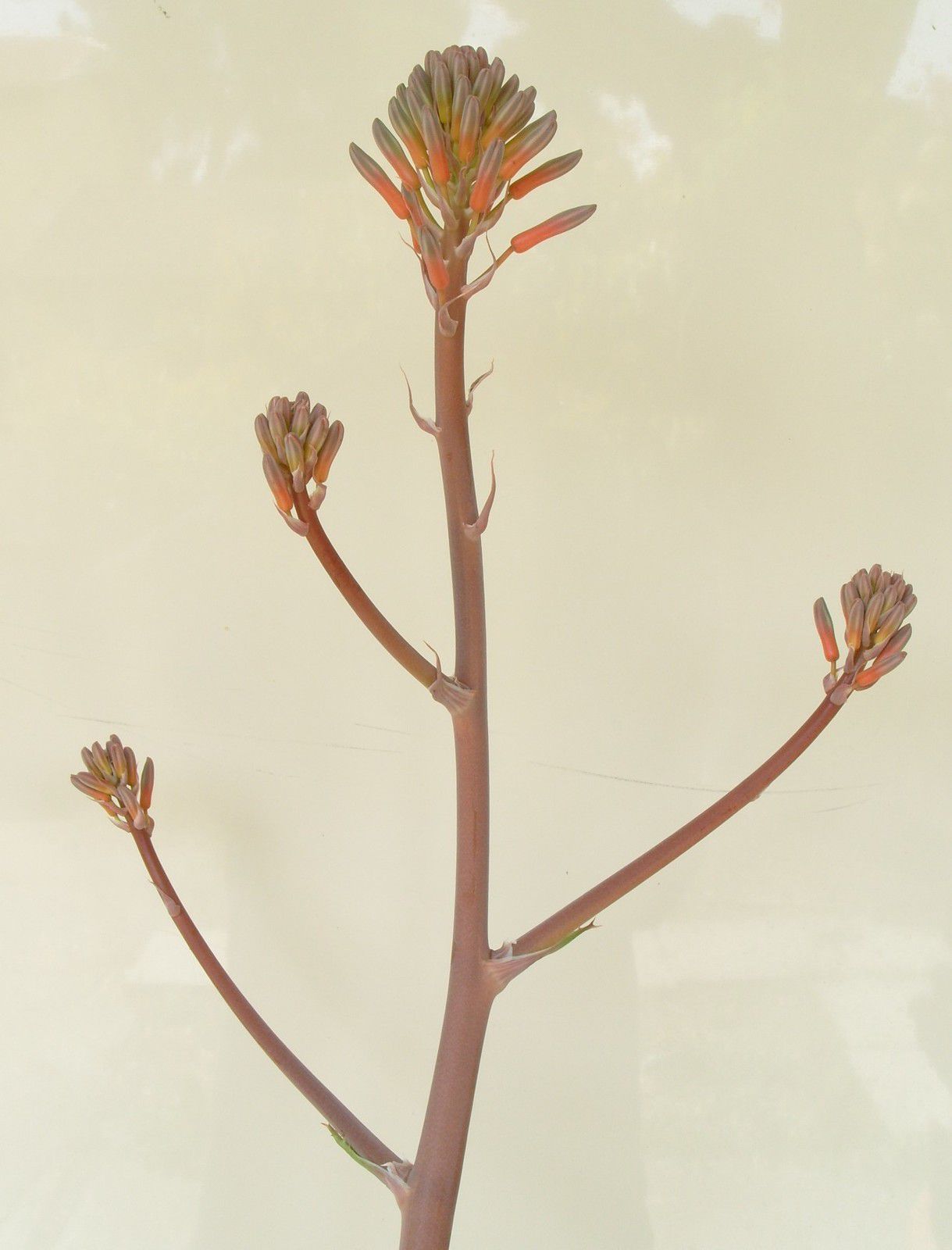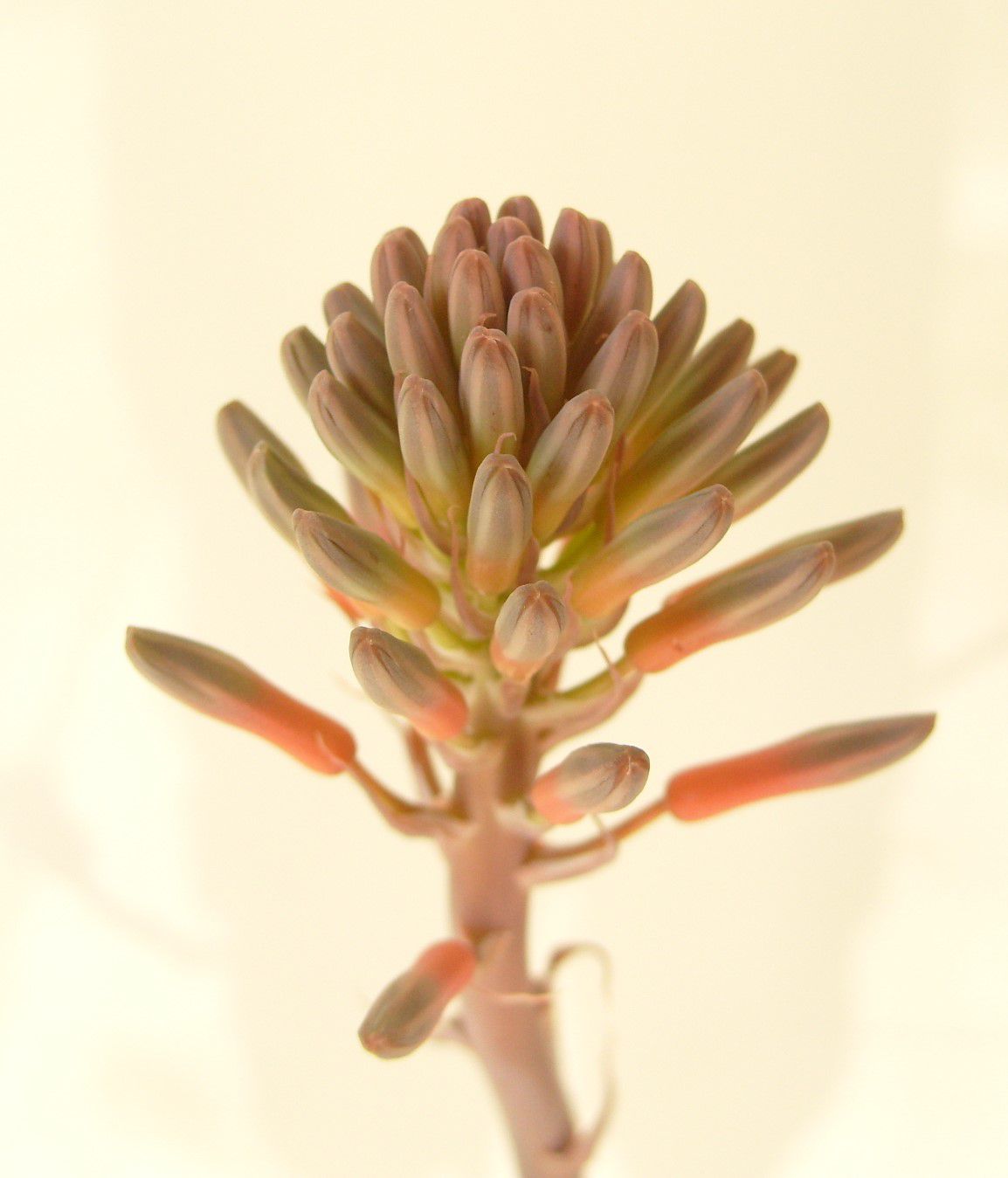Famille des Asphodelaceae
Genre: Aloe Linné 1753
Nom scientifique: Aloe maculata
Allioni 1773
Aloe saponaria, (Aiton) Haw. 1804
Distributions: Afrique du Sud, Lesotho, Swaziland, Zimbabwe.
Etymologie: origine incertaine, de l'Arabe "alloch" = amère ou "alloeh", du Grec "aloe" ou de l'Hébreu "ahalim ou allal" = amère;
maculata, (maculatus) = dérivé du Latin signifiant tacheté.
Synonyme: Aloe saponaria.
Température de rusticité: - 7 °C si sol bien drainé.
Exposition: plein soleil.
Culture: nécessite un substrat drainant de type cactées. Arroser de Mars à Octobre puis diminuer les arrosages en hiver (une fois par mois par beau temps). Peut être planté en extérieur dans le Sud de la France.
Floraison en Avril - Juin. La fleur dure 1 mois environ.





Coupe longitudinale de la fleur.
La fleur mesure 35 mm de longueur.


(Provenance: Jardinerie Cactus et Palmiers, 83320 Carqueiranne)
https://foudecactus.com/pages/Producteurs_de_cactees_et_de_plantes_succulentes-6477144.html
-------------------------------------------------------
Données supplémentaires
1) Aloe maculata All. (Aloe saponaria)
The widely distributed Soap Aloe extends from the Cap Peninsula to KwaZulu-Natal in South Africa, Lesotho, Swaziland and Zimbabwe (Inyanga). A stemless, handsome species which is the most variable of all the spotted (maculate) aloes; the leaves are thickly fleshy, spreading-ascending with spiny margins; its densely capitate flowers come in shades of yellow, orange, pink and red. The inflorescence which is 40-60 cm tall in suckering plants may be taller in single specimens. Various forms from wide apart areas flower in winter, spring and summer. It is frequently cultivated, but because it suckers vigorously, plants are often added to garden refuse and dumped; this only adds to their further dispersal! The species was cultivated in Europe in 1732.
Référence: Doreen Court, dans "Succulent Flora of Southern Africa", Revised Edition, Struik Nature Edition, p 241, 2010.
2) Aloe maculata
Allioni, Auct. Syn.: 13 (1773)
Plant stemless or with a stout stem to 50 cm high, occasionally more, solitary or suckering to form small groups. Leaves 12-20 in a dense rosette, spreading, ovate-lanceolate with withered tips, 25-30 x 8-12 cm, upper surface dark green with many elongated whitish spots in transverse bands, lower surface paler, usually unspotted, lineate; margins with brown, pungent teeth 3-5 mm long, about 10 mm apart. Inflorescence 40-100 cm high, with 3-7 branches curving widely upwards. Peduncle stout, with scarious bracts subtending the branches. Raceme capitate, 10-12 x 12-16 cm, flat-topped to rounded, densely flowered. Floral bracts linear-lanceolate, scarious, 13-20 mm long. Pedicels 35-45 mm long. Perianth salmon-pink to orange, yellow or red, cylindrical, 35-45 mm long, 10 mm across the ovary, abruptly constricted above to 6 mm, then widening towards the mouth; outer tepals free for 10-15 mm, tips slightly spreading. Stamens and style scarcely exserted.
South Africa Precise type locality not know. The holotype is an illustration (iconotype) in Commelin's Hort. Med. Amstel. 2: fig. 5 (1701), a cultivated plant without flowers that was grown from seed sent from Africa. It is widespread and common from the Cape Peninsula eastwards through the Cape Provinces into KwaZulu-Natal and Mpumalanga, occuring in grassland, scrub and on rocky outcrops, from near the coast to higher altitudes in the Drakensberg.
As is common with widespread species, this is a very variable plant. It can be distinguished most easily by its densely flowered, flat-topped racemes and uniformly coloured flowers. Known as the soap aloe, it was first called A. saponaria by Haworth (1804) until the name A. maculata was found to have priority. A number of species are accepted as conspecific (a. latifolia, A. leptophylla, A. maculosa and A. umbellata) and a variety fickburgensis is considered to be a smaller variant of the species.
Référence: S. Carter, J.J. Lavranos, L.E. Newton, C.C Walker, dans "Aloes, The Definitive Guide", Kew Publishing Edition, p 171, 2011.

/image%2F1217490%2F20211216%2Fob_67e2e1_gymnocalycium-baldianum-9.JPG)


/image%2F1217490%2F20210904%2Fob_80574c_aloe-doran-black-23.JPG)
/image%2F1217490%2F20200209%2Fob_6b6b4c_aloe-melanacantha-2.JPG)
/image%2F1217490%2F20180529%2Fob_48bc3e_img-1476.JPG)
/idata%2F3917426%2FMes-succulentes%2FAloe-somaliensis--4-.JPG)
/image%2F1217490%2F20231001%2Fob_fe4155_epiphyllum-oxypetalum-4.JPG)
/image%2F1217490%2F20231001%2Fob_a20e8e_img-7333.JPG)
/image%2F1217490%2F20231001%2Fob_21283f_kalanchoe-tuniflora-1.JPG)
/image%2F1217490%2F20230121%2Fob_197e7c_blog-parodoa-procera-9.JPG)
/image%2F1217490%2F20230121%2Fob_b113e6_blog-mammillaria-perbella-7.JPG)
/image%2F1217490%2F20230121%2Fob_7e9446_blog-mammillaria-matudae-16.JPG)